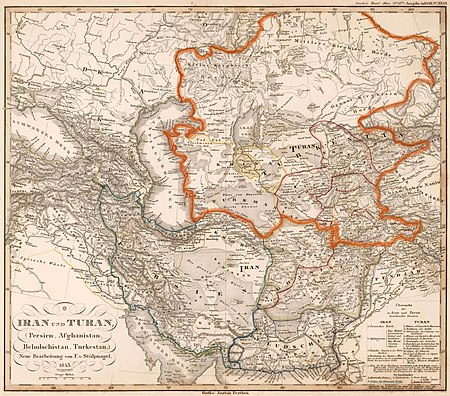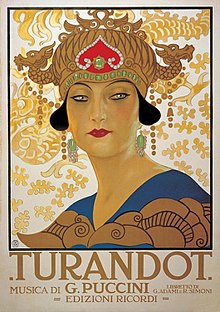
| TURIYA
German "Map of Iran and Turan", dated 1850 (during the Qajar dynasty), Turan territory indicated by orange line (here enhanced). The name "Turan" appears to the east of the Aral Sea.
According to the legend (bottom right of the map), Turan encompasses regions including modern Uzbekistan, Kazakhstan and northern parts of Afghanistan and Pakistan. This area roughly corresponds to what is called Central Asia today.
List of the areas mentioned in the map as part of Turan: 1. Khwarezm 2. Bukhara with Balkh 3. Shehersebz (near Bukhara) 4. Hissar 5. Khokand 6. Durwaz 7. Karategin 8. Kunduz 9. Kafiristan 10. Chitral 11. Gilgit 12. Iskardu 13.14. The northern steppes (Kazakhstan).
Turan is a historical region in Central Asia. The term is of Iranian origin and may refer to a particular prehistoric human settlement, a historic geographical region, or a culture. The original Turanians were an Iranian tribe of the Avestan age.
Overview :
Turan is the ancient Iranian name for Central Asia, literally meaning "the land of the Tur". As described below, the original Turanians are the Tuirya Iranian people of the Avesta age. According to Shahnameh's account, at least 1500 years later after the Avesta, the nomadic tribes who inhabited these lands, were ruled by Tur who was the emperor Fereydun's elder son. The association with Turks is also primarily based on the Shahnameh's geographical account where Turkification of Central Asia was partially completed during that time. Tur/Turaj(Tuzh in Middle Persian) is the son of emperor Fereydun in ancient Iranian mythology. In the Shahnameh, he is identified with the Turks although culturally, there is no relationship between Turanians of the Shahnameh and the culture of ancient Turks. In 19th century and early 20th century discourse, now obsolete, it was primarily an ideological term designating Turkic, Ugric languages, Uralic languages, Dravidian people and people more or less indiscriminately, implying a common ancestry and common culture of the various ethnicities in question.
In ancient Iranian mythology, Tur or Turaj (Tuzh in Middle Persian) is the son of the emperor Fereydun. According to the account in the Shahnameh the nomadic tribes who inhabited these lands were ruled by Tur. In that sense, the Turanians could be members of two Iranian peoples both descending from Fereydun, but with different geographical domains and often at war with each other. Turan, therefore, comprised five areas: the Kopet Dag region, the Atrek valley, the eastern Alborz mountains, Helmand valley, Bactria and Margiana.
A later association of the original Turanians with Turkic peoples is based primarily on the subsequent Turkification of Central Asia, including the above areas. According to C. E. Bosworth, however, there was no cultural relationship between the ancient Turkic cultures and the Turanians of the Shahnameh.
Terminology :
Avesta :
The
oldest existing mention of Turan is in the Farvardin yashts, which
are in the Young Avestan language and have been dated by linguists
to approximately 2300 BCE. According to Gherardo Gnoli, the Avesta
contains the names of various tribes who lived in proximity to each
other: "the Airyas [Aryans], Tuiryas [Turanians], Sairimas
[Sarmatians], Sainus [Ashkuns] and Dahis [Dahae]". In the hymns
of the Avesta, the adjective Turya is attached to various enemies
of Zoroastrism like Fra?rasyan (Shahnameh: Afrasiab). The word occurs
only once in the Gathas, but 20 times in the later parts of the
Avesta. The Tuiryas as they were called in Avesta play a more important
role in the Avesta than the Sairimas, Sainus and Dahis. Zoroaster
himself hailed from the Airya people but he also preached his message
to other neighboring tribes.
Late Sassanid and early Islamic era :
Turan was one of the regions of the Sasanian Empire, here seen at the extreme southeast From
the 5th century CE, the Sasanian Empire defined "Turan"
in opposition to "Iran", as the land where lay its enemies
to the northeast.
According
to Clifford E. Boseworth :
Shahnameh :
In
the Persian epic Shahnameh, the term Turan ("land of the Turya"
like Eran, Iran = "land of the Arya") refers to the inhabitants
of the eastern-Iranian border and beyond the Oxus. According to
the foundation myth given in the Shahnameh, King Firedun (= Avestan
Traetaona) had three sons, Salm, Tur and Iraj, among whom he divided
the world: Asia Minor was given to Salm, Turan to Tur and Iran to
Iraj. The older brothers killed the younger, but he was avenged
by his grandson, and the Iranians became the rulers of the world.
However, the war continued for generations. In the Shahnameh, the
word Turan appears nearly 150 times and that of Iran nearly 750
times.
Ideology
:
Polish philosopher Feliks Koneczny claimed the existence of a distinctive Turanian civilization, encompassing both Turkic and some Slavs, such as Russians. This alleged civilization's hallmark would be militarism, anti-intellectualism and an absolute obedience to the ruler. Koneczny saw this civilization as inherently inferior to Latin (Western European) civilization.
Politics :
Poster of the opera by Puccini, Turandot (1926). The name of the opera is based on Turan-Dokht ("daughter of Turan"), which is a common name used in Persian poetry for Central Asian princesses
In the declining days of the Ottoman Empire, some Turkish nationalists
adopted the word Turanian to express a pan-Turkic ideology, also
called Turanism. As of 2013 Turanism forms an important aspect of
the ideology of the Turkish Nationalist Movement Party (MHP), whose
members are also known as Grey Wolves. |


